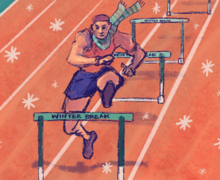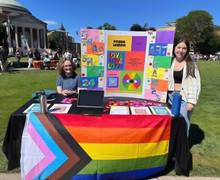Syracuse’s wide receiving core flashes potential without Harris in loss to FSU
Elizabeth Billman | Senior Staff Photographer
Damien Alford recorded 29 receiving yards in the loss against Florida State.
Get the latest Syracuse news delivered right to your inbox.
Subscribe to our sports newsletter here.
Through the first four games of the season, Syracuse didn’t show much wide receiver depth beyond No. 1 option Taj Harris. Sean Tucker was the team’s leader in receiving yards (175) largely due to checkdowns and short outlet passes from quarterbacks Tommy DeVito and Garrett Shrader. Harris was a close second with 171 receiving yards in three games.
So when news broke Saturday afternoon that Harris hadn’t traveled with the team to Tallahassee, questions arose about the Orange’s passing abilities in the game against Florida State.
The offense was already one-dimensional in SU’s 24-21 victory over Liberty, one that featured just six completions and 77 yards through the air compared to 228 on the ground. Harris led the receiving core with two catches for 20 yards.
Head coach Dino Babers said he had “no update” on why Harris didn’t travel after Syracuse’s (4-2, 0-1 Atlantic Coast) 33-30 loss to Florida State (1-4, 1-2 ACC). Babers did, however, emphasize that SU had the necessary options available from the team. In Shrader’s second start, he posted 150 yards and a touchdown through the air in addition to a monstrous game on the ground. Courtney Jackson, Anthony Queeley and Damien Alford led the Orange’s receiving core with 57, 50 and 29 yards, respectively.
“We had more than enough in that locker room we were in,” Babers said when asked about Harris’ absence. “We were disappointed that we came up three points short, (but) we had more than enough in that locker room to win this game, more than enough.”
This wasn’t the first time this year that SU played without Harris. Against UAlbany, Harris was sidelined with what appeared to be an injury on his left leg (it was wrapped with tape). During that game, Alford caught a 73-yard touchdown on a deep throw from DeVito. Jackson added another 47 yards on three catches, and Tucker shined with three catches for 121 yards and a touchdown in addition to another four touchdowns on the ground.
But UAlbany was a Football Championship Subdivision team with a porous defense. Florida State, despite its 0-4 record entering Saturday’s game, was different.
Shrader and the offense started slow with a turnover on downs and three drives that went three-and-out. But after SU’s fifth possession, one that included a short stop-and-go route by Sharod Johnson for 11 yards and a 55-yard touchdown run from Shrader in the second quarter, the offense came to life.
The Mississippi State transfer rolled to his right and fired a crossing pattern pass to Alford for a 12-yard gain. After a Tucker rush, Shrader faked the handoff, rolled once again and hit Alford for another 16 yards.
Jackson turned a short pass at the sticks into a missed tackle and a 26-yard gain upfield right before halftime, setting up a Hail Mary attempt from Shrader that landed in the crowd and was intercepted.
At halftime, Babers said Syracuse had to make sure it kept hitting “some of those play-action passes” to assure it had a “balanced attack.”
Queeley didn’t catch a pass until the fourth quarter. But once Shrader got him involved on SU’s first possession of the final 15 minutes, when SU was trailing by 10 points, it paid off. The wide receiver said the Orange had been working on a lot of crossing routes during practice. They stayed late this week to get more repetitions in, all with the goal of helping Shrader become more comfortable in the offense. That’d make the receiving core more comfortable too, he explained.
“The crossing routes were perfect,” Queeley said after the game, referring to his 26-yard touchdown that made it 30-27, FSU.
On his first catch, Queeley ran a crosser and snagged the pass from Shrader for a 24-yard gain. Then Jackson caught a screen pass and shifted through defenders for a gain of nine before Shrader took a 26-yard deep shot toward Devaughn Cooper. The pass dropped right in the bucket, but Cooper was mere feet over the back end zone line and had to run back to the line of scrimmage.
Shrader hung in the pocket and went right back to Queeley when the crossing route left the latter wide-open in the middle of the field, and the wide receiver turned upfield and extended for the pylon.
“That was a really, really nice job, but Q’s been around for a long time,” Babers said. “He’s caught a lot of balls, I was excited to see his play and excited to watch the tape to see how his overall game was.”
Shrader targeted Queeley in the endzone with a chance to take the lead one possession later, but the receiver was double-covered. Shrader rose from his knees after the throw, pointing to his chest to take responsibility for the ill-advised throw. He tried to find Queeley on a deep shot one possession later, but the receiver and defensive back got into a tangle of sorts and Queeley appeared to trip. After the game, he said he believed it was pass interference.
The referees didn’t call it, and SU’s punt led to Florida State’s game-winning drive.
Babers said two weeks ago the UAlbany game without Harris was a good opportunity to assess his other receivers and get them involved. Against the Seminoles, despite the loss and an offense that is still largely reliant on the run via Shrader and Tucker, the wide receiving core again showed what it’s capable of.
“Whoever’s not out there, we just have to step up as a unit,” Queeley said. “We’re a whole family, we just gotta get the job done and step up.”
Published on October 2, 2021 at 9:49 pm
Contact Roshan: rferna04@syr.edu | @Roshan_f16






